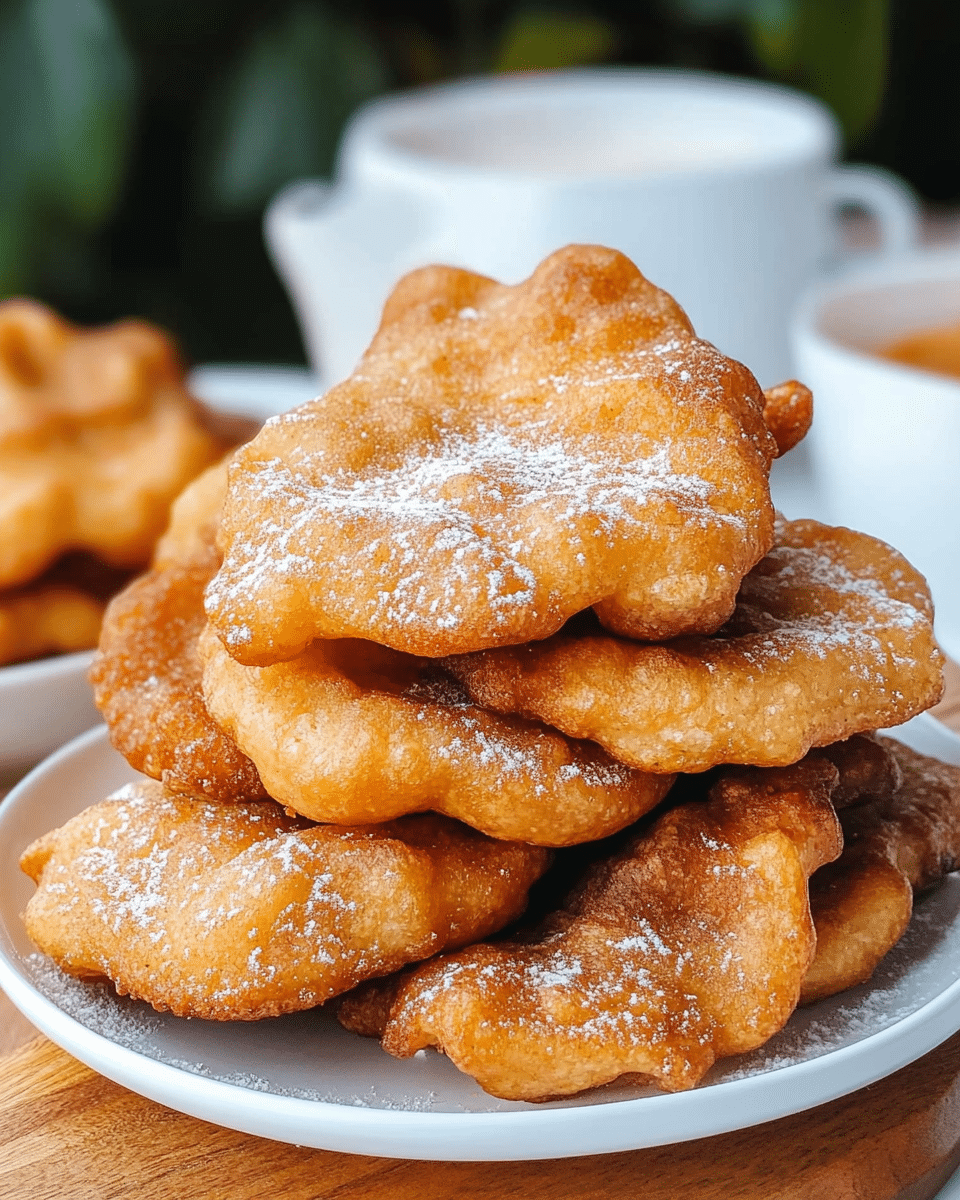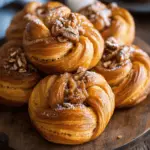Buñuelos are a classic Mexican dessert known for their golden, crispy texture and irresistible cinnamon sugar coating. Traditionally enjoyed during Christmas, New Year’s, and festive celebrations, they bring warmth and sweetness to gatherings. Each crunchy bite carries a nostalgic reminder of family traditions, laughter, and cozy evenings spent sharing food around the table.
What makes buñuelos so special is their simple yet delightful preparation. A humble dough is transformed into thin, airy discs, fried to perfection, and dusted with sugar and cinnamon. Served warm, they pair beautifully with hot chocolate, café de olla, or even drizzled with piloncillo syrup for extra indulgence. Whether you’re making them for the holidays or just to satisfy a sweet craving, buñuelos are a timeless treat that embodies comfort, celebration, and tradition in every bite.
Full Recipe:
Ingredients:
-
2 cups all-purpose flour
-
1 teaspoon baking powder
-
1/2 teaspoon salt
-
2 tablespoons granulated sugar
-
2 tablespoons unsalted butter, softened
-
1 large egg
-
1/2 cup warm milk (plus more as needed)
-
Vegetable oil for frying
Cinnamon Sugar Topping:
-
1 cup granulated sugar
-
1 tablespoon ground cinnamon
Directions:
-
In a large bowl, whisk together flour, baking powder, salt, and sugar.
-
Add butter, egg, and warm milk, mixing until a soft dough forms. Knead until smooth and elastic, about 5-7 minutes.
-
Cover the dough with a towel and let it rest for 30 minutes.
-
Divide dough into small balls and roll each one into a very thin circle (like a tortilla).
-
Heat vegetable oil in a large skillet over medium heat until hot.
-
Fry each dough round one at a time, pressing lightly with a spatula so they puff up. Fry until golden brown, about 1-2 minutes per side.
-
Drain on paper towels.
-
Mix sugar and cinnamon in a shallow bowl. While still warm, sprinkle or coat each buñuelo generously in the cinnamon-sugar mixture.
Prep Time: 15 minutes | Resting Time: 30 minutes | Cooking Time: 15 minutes | Total Time: 1 hour
Kcal: 220 kcal | Servings: 8 buñuelos
Buñuelos: A Sweet Mexican Tradition
Buñuelos are one of the most cherished desserts in Mexican cuisine, embodying warmth, festivity, and the essence of family gatherings. These delightful fritters are thin, crispy discs of dough that are fried to golden perfection and coated in cinnamon sugar or sometimes drizzled with piloncillo syrup. For many families across Mexico and Latin America, buñuelos are more than just a dessert, they represent heritage, celebration, and a comforting sense of nostalgia.
A Brief History of Buñuelos
The origins of buñuelos can be traced back to Spain, where Moorish influences introduced fried dough pastries centuries ago. When Spanish settlers arrived in Latin America, they brought with them many culinary traditions, and buñuelos quickly became one of the beloved desserts that adapted to local ingredients and tastes. Over time, Mexico developed its own unique version of buñuelos, shaping them into thin, crunchy discs rather than the round fritters found in other countries.
In Mexico, buñuelos are strongly associated with Christmas, New Year’s, and Día de los Reyes (Three Kings Day). They are often enjoyed with steaming cups of hot chocolate or café de olla, the spiced coffee sweetened with piloncillo. The tradition of eating buñuelos during the holidays is linked to the belief that breaking or biting into something crunchy symbolizes breaking away from the old year’s problems and welcoming good fortune for the year ahead.
Cultural Significance
Buñuelos are more than just a sweet treat, they are deeply tied to family and cultural traditions. During December festivities, it is common to see street vendors selling freshly fried buñuelos stacked in tall piles, their aroma of cinnamon sugar filling the air. Families also gather in their kitchens to prepare buñuelos together, rolling out the dough, frying, and dusting them in sugar while chatting, laughing, and sharing stories.
In some regions, the tradition includes eating buñuelos on New Year’s Eve and then tossing the clay plates they were served on into the street, symbolizing the shattering of misfortunes and the welcoming of prosperity. While not everyone practices this custom today, the symbolic meaning of starting fresh while enjoying a warm buñuelo remains a cherished aspect of the dessert.
Variations of Buñuelos
Though the most popular Mexican version of buñuelos is the thin, round disc sprinkled with cinnamon sugar, there are several variations across Latin America and even within Mexico.
-
Buñuelos de Rodilla (Knee Buñuelos): Named because traditionally the dough was stretched over a person’s knee to create ultra-thin rounds before frying.
-
Colombian Buñuelos: Small, round, cheesy fritters made with cassava flour and cheese.
-
Guatemalan Buñuelos: Round fritters served with a sweet syrup.
-
Spanish Buñuelos: Often filled with custard, cream, or chocolate, resembling doughnut holes.
These variations highlight how one simple concept, fried dough, has taken on unique cultural identities across different countries, each adding its own flair and flavor profile.
How Buñuelos Are Made
The magic of buñuelos lies in their simplicity. The dough is typically made with flour, baking powder, sugar, a touch of fat like butter or shortening, and milk. After resting, the dough is rolled out into thin circles and fried until golden and bubbly. What makes them unique is the texture, they are not meant to be soft like doughnuts but thin and crispy, almost like a sweet tostada.
Once fried, they are dusted with a generous coating of cinnamon sugar, giving them their iconic flavor. In some regions, buñuelos are served with a drizzle of syrup made from piloncillo (unrefined cane sugar), cinnamon, and anise, adding a deep caramel-like richness that perfectly complements the crunchy fritter.
Serving Suggestions
Buñuelos are incredibly versatile and can be served in many delicious ways:
-
Classic Cinnamon Sugar: The traditional style, perfect for enjoying with a hot beverage.
-
With Piloncillo Syrup: For a deeper, caramelized sweetness.
-
Paired with Hot Chocolate: Especially popular during Christmas posadas.
-
With Fresh Fruit: A modern twist includes topping them with fruit compote or whipped cream.
-
As an Ice Cream Base: Use a buñuelo as a crispy base for a scoop of vanilla or cinnamon ice cream.
Tips for Making the Best Buñuelos
-
Roll them thin: The thinner the dough, the crispier the buñuelos will be.
-
Use hot oil: Make sure the oil is properly heated before frying so the dough puffs up and crisps quickly.
-
Drain excess oil: Place the fried buñuelos on paper towels to keep them light and crunchy.
-
Coat while warm: Sprinkle or dip them in cinnamon sugar while still hot so the coating sticks.
-
Serve immediately: Buñuelos are best enjoyed fresh and warm, though they can stay crisp for a few hours if stored properly.
Why You’ll Love Buñuelos
Buñuelos are the kind of dessert that brings joy to both the cook and those who eat them. They’re fun to make, especially with family, since rolling and frying the dough becomes a shared activity. The flavor is simple yet irresistible: the crunch of fried dough combined with the sweetness of cinnamon sugar creates a treat that appeals to all ages.
They’re also highly adaptable, whether you stick with tradition or give them a modern twist, buñuelos are a perfect canvas for creativity. Their presence on the holiday table instantly signals celebration, warmth, and togetherness.
Health and Moderation
While buñuelos are a fried dessert, they can still be enjoyed in moderation as part of a balanced diet. Making them at home gives you more control over the ingredients, you can use less sugar, substitute whole wheat flour for part of the dough, or experiment with baking instead of frying. Though the fried version remains the traditional favorite, lighter alternatives are becoming popular among health-conscious cooks.
Buñuelos Beyond the Holidays
Although buñuelos are most closely tied to Christmas and New Year celebrations, there’s no reason they can’t be enjoyed year-round. Their simplicity and comforting flavors make them a great option for weekend treats, family gatherings, or even as a unique dessert offering at parties. They also pair wonderfully with coffee or tea, making them a delightful companion for an afternoon pick-me-up.
Conclusion
Buñuelos are far more than just fried dough coated in sugar, they are a celebration of culture, family, and tradition. With roots tracing back to Spain but firmly embraced and transformed by Mexican culture, they have become a symbol of holiday joy and festive spirit. Whether served plain with cinnamon sugar or dressed up with syrup and toppings, buñuelos carry a timeless charm that continues to unite generations around the table.
By learning to make buñuelos at home, you are not only creating a delicious dessert but also keeping a cherished tradition alive. Each golden, crispy disc is a reminder of history, heritage, and the simple pleasure of sharing sweet moments with loved ones.






